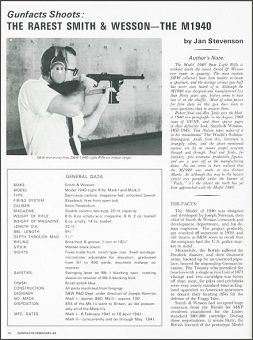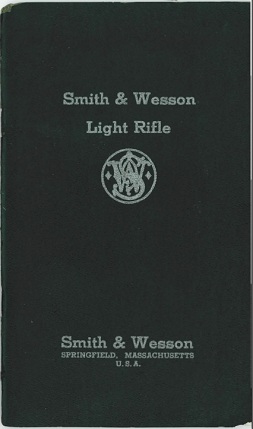Development of the Smith & Wesson Light Rifle began in 1939, probably intended for the police and security market. It happened to coincide very neatly with the disastrous British evacuation of Dunkirk and their subsequent need for firearms of basically any type. S&W was making revolver under British military contract, and the Model 1940 Light Rifle found its way into British hands as well. Two different versions were made, the Mk I and Mk II.
The design was out of date before it was ever begun, and had a number of definite problems. It was a straight blowback, open bolt rifle chambered for the 9mm Luger cartridge. In the Mk I rifles, the bolt had a floating firing pin and hammer built into it, with the hammer activated by camming against a protrusion in the front of the receiver. This ensured that the bolt would be fully seated before a round fired, although this prevented the action from utilizing the forward momentum of the bolt to counter some of the recoil from firing. The Mk II design replaced this mechanism with a standard fixed firing pin.
The M1940 used 20-round magazines, loaded into the front of the magwell rather than the bottom. The magazine well also housed a vertical tube through which empty cases were ejected. This sounds like a good idea from a static range perspective, but as a byproduct prevents the shooter from checking the chamber or clearing malfunctions – the only access to the inside of the receiver is through six inches of ejection tube.
The manufacture of the M1940 was very expensive, considering its function. It used a barrel that was both fluted (12 longitudinal flutes, each milled separately) and tapered, when a plain cylindrical barrel would have been perfectly sufficient. Virtually every internal part was milled, including the receiver – which really should have been made of simple seamless tubing.
Worst of all, the rear of the receiver was threaded to attach to the rear cap, and the receiver wall was not thick enough for this purpose. The threads cut deeply enough to leave a very thin wall at the end of the receiver, and the bolt beat against the threaded cap with every shot, thanks to a fairly light recoil spring. After about a thousand rounds, the threaded section of he receiver tended to snap off. This was only exacerbated in the Mk II version of the gun, which was intended to fire a hot-loaded 9mm specified by the British military.
Not that any more problems are needed to understand the British rejection of the Light Rifle, but one should also note that it was a semi-automatic only, 9-lb, 32″ long rifle firing 9×19 cartridges from a 9″ barrel. This did not make for a desirable balance of bulk and firepower.
The British rejected the rifle after receiving about 950 of them (of both Marks), and they are believed to have been destroyed. A handful remained at S&W, having not been shipped before the program was cancelled. These were recognized and Curio and Relic pieces in the 70s, exempted from the NFA (the short barrels would otherwise make them SBRs), and sold to the public. Between the small number released and the limited lifespan of the receiver, they remain very rare guns today.
Manual
- Smith & Wesson Model 1940 Light Rifle manual (English)
Resources



The British: “We said we wanted a Light Rifle not an abortion.”